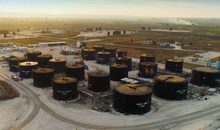
 Flash News
Flash News
Gunfire in Durres, a 30-year-old man is injured
Accident on Arbri Street, car goes off the road, two injured
Arrests of "Bankers Petrolium", Prosecution provides details: Exported and sold 532 billion lek of oil, caused millions of euros in damage to the state
Ndahet nga jeta tragjikisht në moshën 28-vjeçare ylli i Liverpool, Diogo Jota
Posta e mëngjesit/ Me 2 rreshta: Çfarë pati rëndësi dje në Shqipëri

The ratio of non-performing loans was also stable for the month of July. According to data from the Bank of Albania, this indicator suffered a very slight decrease to 4.68%, from 4.7% that had been for June. On an annual basis, however, the NPL ratio continues to decline. A year ago, this indicator was at the level of 5.28%.
During the first part of 2024, the ratio of non-performing loans has not shown very large fluctuations and is currently not far from the 4.74% level that was recorded at the end of last year.
However, the fact that the ratio of non-performing loans is stable, despite the rapid growth of the loan portfolio, is an indication that the amount of non-performing loans is increasing in absolute terms.
At the end of July, the total loan portfolio for the economy reached the value of ALL 798.3 billion, with an annual increase of 13.3%. Above this value, the total number of problem loans is estimated at approximately 37.3 billion ALL, from around 35 billion ALL at the end of 2023.
The rapid growth of credit for the economy, which on the other hand is not accompanied by a significant decrease in the ratio of non-performing loans, is also worrying the Bank of Albania.
In the Declaration of Financial Stability approved last week, the Bank of Albania assesses that the risks of the banking sector's activity are presented at controlled levels, but underlines that the growing trend of the financial cycle needs to be moderated.
In the middle of this year, the Bank of Albania decided to apply for the first time a countercyclical addition to the capital adequacy ratio of the banking sector.
According to the decision of the Governor, Gent Sejko, the rate of countercyclical capital addition (KUNC) for Albania will be 0.25 percentage points, from zero that was foreseen in the previous decision. All commercial banks in Albania must complete this supplement after one year, starting on June 30, 2025.
The application of a countercyclical capital supplement is provided for in the 2018 regulation "On macroprudential capital supplements. Such an addition is aimed at slowing down lending, in case the central bank estimates that it is growing at too fast a pace.
During the first part of 2024, the Albanian economy is in a situation where the reduction of inflation below the objective of the Bank of Albania is combined with the rapid growth of lending. On the other hand, the performance of the banking sector is quite good, with profits that have reached the highest historical values. This is influencing a greater appetite for risk and a high supply of credit.
Such a situation somewhat complicates the future decision-making of the Bank of Albania. The further reduction of interest rates from the current level of 3% may further promote the growth of lending, which the Bank of Albania currently does not encourage, due to the increased risks it may pose to financial stability./ Monitor. al
Latest news










Greece imposes fee to visit Santorini, how many euros tourists must pay
2025-07-03 20:50:37
Don't make fun of the highlanders, Elisa!
2025-07-03 20:43:43
Gunfire in Durres, a 30-year-old man is injured
2025-07-03 20:30:52

The recount in Fier cast doubt on the integrity of the vote
2025-07-03 20:09:03




Heatwave has left at least 9 dead this week in Europe
2025-07-03 19:00:01

Oil exploitation, Bankers accused of 20-year fraud scheme
2025-07-03 18:33:52
Three drinks that make you sweat less in the summer
2025-07-03 18:19:35
What we know so far about the deaths of Diogo Jota and his brother André Silva
2025-07-03 18:01:56



Another heat wave is expected to grip Europe
2025-07-03 17:10:58

Accident on Arbri Street, car goes off the road, two injured
2025-07-03 16:45:27

Accused of two murders, England says "NO" to Ilirjan Zeqaj's extradition
2025-07-03 16:25:05





Gaza rescue teams: Israeli forces killed 25 people, 12 in shelters
2025-07-03 15:08:43
Diddy's trial ends, producer denied bail
2025-07-03 15:02:41

Agricultural production costs are rising rapidly, 4.8% in 2024
2025-07-03 14:55:13
Warning signs of poor blood circulation
2025-07-03 14:49:47
Croatia recommends its citizens not to travel to Serbia
2025-07-03 14:31:19
Berisha: Albania is the blackest stain in Europe for the export of emigrants
2025-07-03 14:20:19


'Ministry of Smoke': Activists Blame Government for Wasteland Fires
2025-07-03 13:59:09

AFF message of condolences for the tragic loss of Diogo Jota and his brother
2025-07-03 13:41:36
Five healthy foods you should add to your diet
2025-07-03 13:30:19






A unique summer season, full of rhythm and rewards for Credins bank customers!
2025-07-03 12:12:20

Fire situation in the country, 29 fires reported in 24 hours
2025-07-03 12:00:04
The constitution of the Kosovo Assembly fails for the 41st time
2025-07-03 11:59:57
The gendering of politics
2025-07-03 11:48:36

The price we pay after the "elections"
2025-07-03 11:25:39

Xhafa: The fire at the Elbasan landfill was deliberately lit to destroy evidence
2025-07-03 11:08:43

The 3 zodiac signs that will have financial growth during July
2025-07-03 10:48:01
Democratic MP talks about the incinerator, Spiropali turns off her microphone
2025-07-03 10:39:24

Ndahet nga jeta tragjikisht në moshën 28-vjeçare ylli i Liverpool, Diogo Jota
2025-07-03 10:21:03
Cocaine trafficking network in Greece, including Albanians, uncovered
2025-07-03 10:10:12



Korreshi: Election manipulation began long before the voting date
2025-07-03 09:39:13
Arrest of Greek customs officer 'paralyzes' vehicle traffic at Qafë Botë
2025-07-03 09:28:41
After Tirana and Fier, the boxes are opened in Durrës today
2025-07-03 09:21:10
Enea Mihaj transfers to the USA, will play as an opponent of Messi and Uzun
2025-07-03 09:10:04

Foreign exchange, the rate at which foreign currencies are sold and bought
2025-07-03 08:53:50
Index, Albania has the worst quality of life in Europe
2025-07-03 08:48:10


Horoscope, what do the stars have in store for you today?
2025-07-03 08:17:05
Clear weather and high temperatures, here's the forecast for this Thursday
2025-07-03 08:00:37
Posta e mëngjesit/ Me 2 rreshta: Çfarë pati rëndësi dje në Shqipëri
2025-07-03 07:46:48



Lufta në Gaza/ Pse Netanyahu do vetëm një armëpushim 60-ditor, jo të përhershëm?
2025-07-02 21:56:08
US suspends some military aid to Ukraine
2025-07-02 21:40:55



Methadone shortage, users return to heroin: We steal to buy it
2025-07-02 20:57:35
Government enters oil market, Rama: New price for consumers
2025-07-02 20:43:30
WHO calls for 50% price hike for tobacco, alcohol and sugary drinks
2025-07-02 20:41:53



